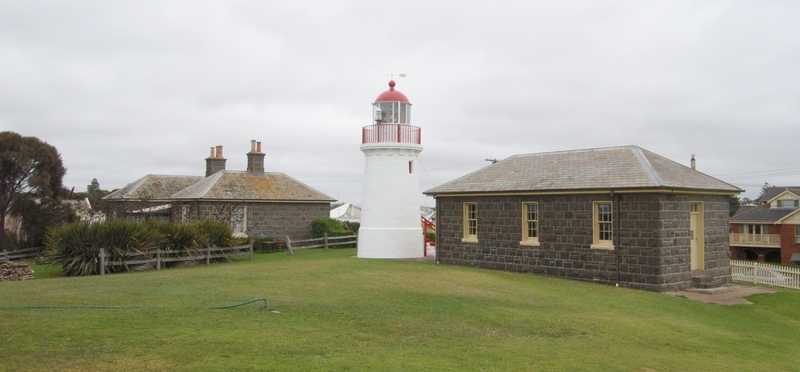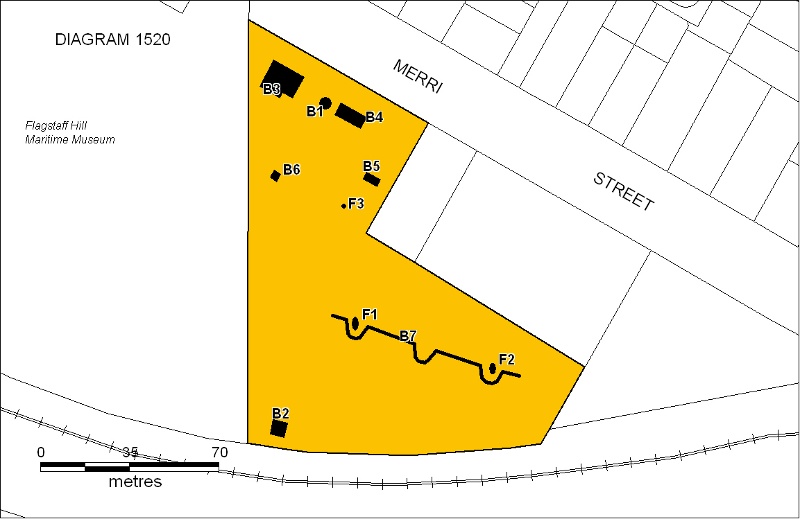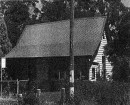LADY BAY LIGHTHOUSE COMPLEX
83-89 MERRI STREET WARRNAMBOOL, WARRNAMBOOL CITY
-
Add to tour
You must log in to do that.
-
Share
-
Shortlist place
You must log in to do that.
- Download report
















Statement of Significance
What is significant?
The Lady Bay Lighthouse Complex was originally built in 1858-9 of basalt quarried on the Salt Water (Maribyrnong) River, Melbourne. The upper tower, chartroom, cottage and privy were originally located on Middle Island, and the lower light was formerly located on a timber tower on the beach. In 1871 the lights were moved to Flagstaff Hill as leading lights for the entry to the treacherous and shallow Warrnambool Harbour. The lower light was placed on a bluestone obelisk that had been erected there as a navigation marker in 1854. A flagstaff had been erected on the hill as early as 1853. The battery of two 80 pounder rifled, muzzle loading guns was added in 1887 as part of a general upgrade to the defences of Victoria which saw Port Phillip Bay transformed into a fortress and the nearby ports of Belfast (Port Fairy) and Portland receive a similar armament to Warrnambool. The fortifications and guns were in a derelict condition until they were restored after the complex was integrated into the Flagstaff Hill Maritime Museum in the 1970s.
How is it significant?
The Lady Bay Lighthouse Complex is of historical, scientific (technological) and architectural significance to the State of Victoria.
Why is it significant?
The Lady Bay Lighthouse Complex is of historical significance as a reminder of Victoria?s maritime heritage and the important role played by regional ports in the process of colonial expansion. When Warrnambool was first established, in 1847, its bay was considered to provide a safe harbour. This opinion changed after shipping first began to use it and the need for navigational aids was soon realised. Lighthouses were a vital part of the maritime infrastructure of a colony that was largely dependent on shipping for its communication with the metropolis, for its migrant intake and for its trade with the other Australian colonies and the rest of the world. These lighthouses provide an excellent example of the kind of navigational aids constructed in the early years of regional expansion in Victoria.
The Lady Bay Lighthouse Complex is of historical significance for its intact battery and guns, a strong reminder of Victoria's wealth and determination to protect itself from the perceived threat of invasion in the 1880s. The remaining guns are scientifically (technologically) significant as physical reminders of a time when these weapons represented advanced design in artillery.
The Lady Bay Lighthouse Complex is of architectural significance as a fine example of Public Works Department architecture of the 1850s and 1880s. The modest but dignified and sturdy lighthouse structures are indicative of the importance of lighthouses to the communities that relied upon them to facilitate safe passage for shipping, at a time when such transport was crucial to relatively isolated towns like Warrnambool. The battery revetments and mounds and the magazine chambers are typical of this specialised form of design.
-
-
LADY BAY LIGHTHOUSE COMPLEX - History
Associated People:
LADY BAY LIGHTHOUSE COMPLEX - Permit Exemptions
General Exemptions:General exemptions apply to all places and objects included in the Victorian Heritage Register (VHR). General exemptions have been designed to allow everyday activities, maintenance and changes to your property, which don’t harm its cultural heritage significance, to proceed without the need to obtain approvals under the Heritage Act 2017.Places of worship: In some circumstances, you can alter a place of worship to accommodate religious practices without a permit, but you must notify the Executive Director of Heritage Victoria before you start the works or activities at least 20 business days before the works or activities are to commence.Subdivision/consolidation: Permit exemptions exist for some subdivisions and consolidations. If the subdivision or consolidation is in accordance with a planning permit granted under Part 4 of the Planning and Environment Act 1987 and the application for the planning permit was referred to the Executive Director of Heritage Victoria as a determining referral authority, a permit is not required.Specific exemptions may also apply to your registered place or object. If applicable, these are listed below. Specific exemptions are tailored to the conservation and management needs of an individual registered place or object and set out works and activities that are exempt from the requirements of a permit. Specific exemptions prevail if they conflict with general exemptions. Find out more about heritage permit exemptions here.Specific Exemptions:General Conditions: 1. All exempted alterations are to be planned and carried out in a manner which prevents damage to the fabric of the registered place or object. General Conditions: 2. Should it become apparent during further inspection or the carrying out of works that original or previously hidden or inaccessible details of the place or object are revealed which relate to the significance of the place or object, then the exemption covering such works shall cease and the Executive Director shall be notified as soon as possible. Note: All archaeological places have the potential to contain significant sub-surface artefacts and other remains. In most cases it will be necessary to obtain approval from Heritage Victoria before the undertaking any works that have a significant sub-surface component. General Conditions: 3. If there is a conservation policy and plan approved by the Executive Director, all works shall be in accordance with it. Note: The existence of a Conservation Management Plan or a Heritage Action Plan endorsed by Heritage Victoria provides guidance for the management of the heritage values associated with the site. It may not be necessary to obtain a heritage permit for certain works specified in the management plan. General Conditions: 4. Nothing in this declaration prevents the Executive Director from amending or rescinding all or any of the permit exemptions. General Conditions: 5. Nothing in this declaration exempts owners or their agents from the responsibility to seek relevant planning or building permits from the responsible authorities where applicable. Regular Site Maintenance : The following site maintenance works are permit exempt under section 66 of the Heritage Act 1995, a) regular site maintenance provided the works do not involve the removal or destruction of any significant above-ground features or sub-surface archaeological artefacts or deposits; b) the maintenance of an item to retain its conditions or operation without the removal of or damage to the existing fabric or the introduction of new materials; c) cleaning including the removal of surface deposits, organic growths, or graffiti by the use of low pressure water and natural detergents and mild brushing and scrubbing; d) repairs, conservation and maintenance to plaques, memorials, roads and paths, fences and gates and drainage and irrigation. e) the replacement of existing services such as cabling, plumbing, wiring and fire services that uses existing routes, conduits or voids, and does not involve damage to or the removal of significant fabric. Note: Surface patina which has developed on the fabric may be an important part of the item’s significance and if so needs to be preserved during maintenance and cleaning. Note: Any new materials used for repair must not exacerbate the decay of existing fabric due to chemical incompatibility, obscure existing fabric or limit access to existing fabric for future maintenance. Repair must maximise protection and retention of fabric and include the conservation of existing details or elements. Fire Suppression Duties : The following fire suppression duties are permit exempt under section 66 of the Heritage Act 1995, a) Fire suppression and fire fighting duties provided the works do not involve the removal or destruction of any significant above-ground features or sub-surface archaeological artefacts or deposits; b) Fire suppression activities such as fuel reduction burns, and fire control line construction, provided all significant historical and archaeological features are appropriately recognised and protected; Note: Fire management authorities should be aware of the location, extent and significance of historical and archaeological places when developing fire suppression and fire fighting strategies. The importance of places listed in the Heritage Register must be considered when strategies for fire suppression and management are being developed. Weed and Vermin Control : The following weed and vermin control activities are permit exempt under section 66 of the Heritage Act 1995, a) Weed and vermin control activities provided the works do not involve the removal or destruction of any significant above-ground features or sub-surface archaeological artefacts or deposits; Note: Particular care must be taken with weed and vermin control works where such activities may have a detrimental affect on the significant fabric of a place. Such works may include the removal of ivy, moss or lichen from an historic structure or feature, or the removal of burrows from a site that has archaeological values. Landscape Maintenance : The following landscape maintenance works are permit exempt under section 66 of the Heritage Act 1995, a) landscape maintenance works provided the activities do not involve the removal or destruction of any significant above-ground features or sub-surface archaeological artefacts or deposits; b) watering, mowing, top-dressing and fertilising necessary for the continued health of plants, without damage or major alterations to layout, contours, plant species or other significant landscape features; c) pruning to control size, improve shape, flowering or fruiting and the removal of diseased, dead or dangerous material, not exceeding 20% of the crown of the tree within a period of two years; d) tree surgery by a qualified horticulturalist or tree surgeon necessary for the health of those plants. Public Safety and Security : The following public safety and security activities are permit exempt under section 66 of the Heritage Act 1995, a) public safety and security activities provided the works do not involve the removal or destruction of any significant above-ground structures or sub-surface archaeological artefacts or deposits; b) the erection of temporary security fencing, scaffolding, hoardings or surveillance systems to prevent unauthorised access or secure public safety which will not adversely affect significant fabric of the place including archaeological features; c) development including emergency stabilisation necessary to secure safety where a site feature has been irreparably damaged or destabilised and represents a safety risk to its users or the public. Note: Urgent or emergency site works are to be undertaken by an appropriately qualified specialist such as a structural engineer, or other heritage professional. Signage and Site Interpretation : The following Signage and Site Interpretation activities are permit exempt under section 66 of the Heritage Act 1995, a) signage and site interpretation activities provided the works do not involve the removal or destruction of any significant above-ground structures or sub-surface archaeological artefacts or deposits; b) the erection of non-illuminated signage for the purpose of ensuring public safety or to assist in the interpretation of the heritage significance of the place or object and which will not adversely affect significant fabric including landscape or archaeological features of the place or obstruct significant views of and from heritage values or items; c) signage and site interpretation products must be located and be of a suitable size so as not to obscure or damage significant fabric of the place; d) signage and site interpretation products must be able to be later removed without causing damage to the significant fabric of the place; Note: The development of signage and site interpretation products must be consistent in the use of format, text, logos, themes and other display materials. Note: Where possible, the signage and interpretation material should be consistent with other schemes developed on similar or associated sites. It may be necessary to consult with land managers and other stakeholders concerning existing schemes and strategies for signage and site interpretation. Minor Works : Note: Any Minor Works that in the opinion of the Executive Director will not adversely affect the heritage significance of the place may be exempt from the permit requirements of the Heritage Act. A person proposing to undertake minor works may submit a proposal to the Executive Director. If the Executive Director is satisfied that the proposed works will not adversely affect the heritage values of the site, the applicant may be exempted from the requirement to obtain a heritage permit. If an applicant is uncertain whether a heritage permit is required, it is recommended that the permits co-ordinator be contacted. * minor repairs and maintenance that replace like with like * painting of previously painted surfaces provided that preparation or painting does not destroy evidence of earlier decorative schemes * removal of paint from originally unpainted surfaces by chemical (non-abrasive) means provided that the treatment does not damage the surface being exposedLADY BAY LIGHTHOUSE COMPLEX - Permit Exemption Policy
The main significance of the place lies in the remnants of 19th century lighthouse and defence buildings. The sparse and uncluttered nature of the environs should be retained and any proposed new buildings should be discouraged. Particular emphasis should be placed on clear and unobstructed view lines, particularly to the harbour. The prime position of the signal mast should be maintained. Planting of trees or shrubs which could obscure the sightlines should be avoided.
While the towers may be painted, the stone of the cottage, chartroom and privy should not. The guns should not be painted, but rust treatments should be allowed.
The integration of the buildings into the Flagstaff Hill Maritime Museum has been beneficial both in terms of their conservation and their interpretation. Minor works which allow this kind of use to continue should be allowed provided that they do not pose a threat to the buildings’ integrity or significance.
-
-
-
-
-
WARRNAMBOOL COURT HOUSE
 Victorian Heritage Register H1674
Victorian Heritage Register H1674 -
FORMER POLICE STATION COMPLEX
 Victorian Heritage Register H1698
Victorian Heritage Register H1698 -
COTTAGE
 Victorian Heritage Register H0577
Victorian Heritage Register H0577
-
'Altona' Homestead (Formerly 'Laverton' Homestead) and Logan Reserve
 Hobsons Bay City
Hobsons Bay City
-
-












